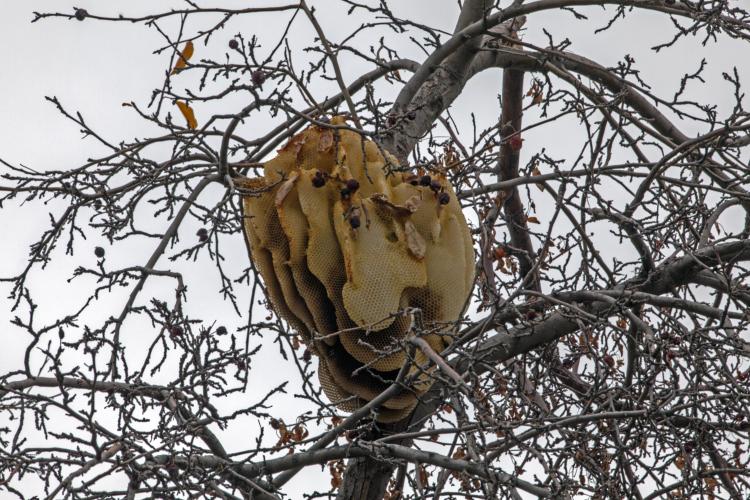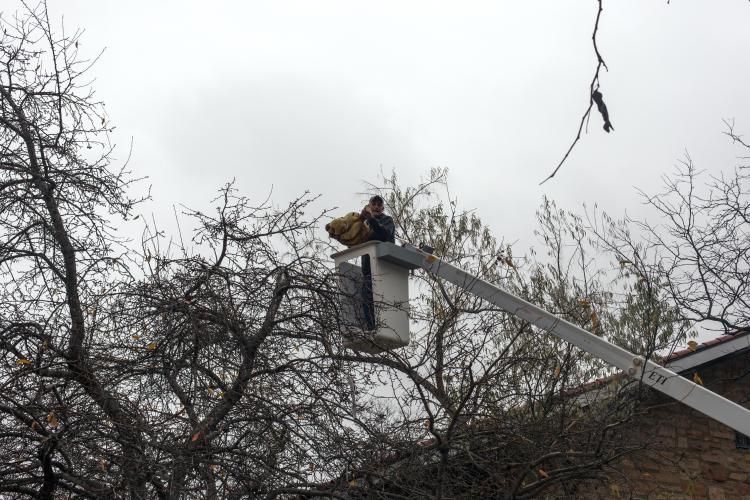A sticky proposition: move a bee hive
Over the years, I have enjoyed talking with Scott Harvey, who is the University of Colorado's Pest Specialist. He has taught me or shown me much about bed bugs and their close relatives bat bugs, bats, bee swarms, and a bear loitering on campus.
Most bee hives are placed in cavities, such as a hollow tree, but this beehive was placed in the crown of a crabapple tree.
From these experiences I have spun off columns on a swarm of bees and an infestation of bed bugs, and this is yet another. He recently invited me to an effort to collect and move a bee hive from the Kittredge dorm cluster on campus.
I showed up early on the cold and cloudy morning of Nov. 17 to photograph the hive. Scott had told me it was in the crown of a tree between Buckingham and Smith dorms, and with the leaves off the trees I had no trouble finding it.
It was about 20 feet above the ground, in the crown of a crabapple tree. Approximately five sheets of comb were fused together, assembled so that one main branch and several smaller branches pierced them.
Although honey bee hives can be found in a variety of places, including rock crevices or in the eaves of houses, most are found in the hollow trunks of trees. A substantial cavity is needed, for the volume needed for a stable, mature hive is equivalent to one or two five-gallon buckets.
Hollow trunks are best because they are easily protected from insects, birds or small mammals that would steal the honey, or the wax, or the larvae developing within the comb. In addition, a hive within a hollow trunk is not exposed to direct sun or wind, so it is easier for bees to regulate its temperature.
What should be done with a beehive in a dorm complex? One consideration is that, exposed to wind, snow, rain and a host of hungry species, an unprotected hive such as this one has a low chance of surviving the winter.
Another consideration is that the university has the responsibility to consider students allergic to bee stings as well as students not comfortable in the company of bees. For these reasons, Scott Harvey and Ed von Bleichert, manager of sustainability and resiliency at CU, decided to move the hive.
Scott arrived as I was photographing the hive, and he showed me the best perspective for a photo. Ed arrived on his bicycle a few minutes later, just in time to witness hostilities among crows, an osprey and a red tailed hawk in a nearby tree. Then Bob Todd and Gary Robinson, both with years of experience with bees, showed up to move the hive. Amy Tetrault, from Facilities Management, drove into the quad in a van with a bucket arm on the back.
After maneuvering the vehicle to the best position, Amy operated the controls to lift Bob up to the hive. He told us that he could see few bees in the hive, a sign that the hive was struggling. Bob used a pruning saw to cut away branches that were in the way and then cut the larger branch that held the hive. He lifted it out of the tree and Amy lowered the bucket so that Bob could hand the hive to Gary.
Gary had brought several hive boxes to serve as the new home for the bees, but the branches protruding from the hive would not allow it to fit into the hive box. But with a little more pruning the hive was placed into the box and the box was closed. I was a bit surprised that a hive could be cut out of a tree and placed in a hive box without a single sting. The low temperature kept almost all of the bees grounded, unable to fly to defend the hive.
Gary will add the hive to others that he keeps as a hobby. I cannot say whether they will survive the winter, but their probability is much higher now that they are protected from wind, snow, rain and animals eager to eat the honey, the comb, or the larvae.
I am proud that CU takes the time to help a hapless hive built in an inopportune site.



